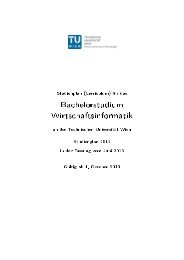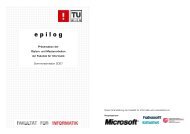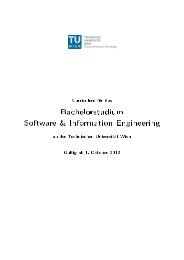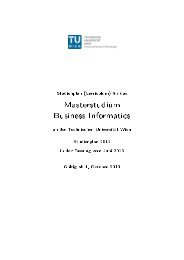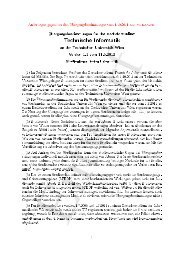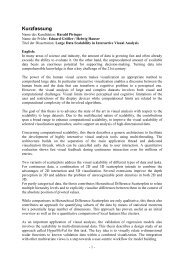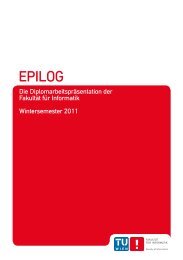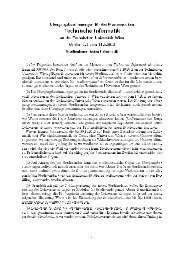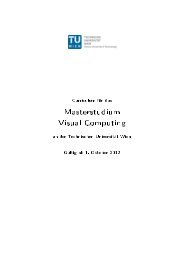Abstract-Band - Fakultät für Informatik, TU Wien - Technische ...
Abstract-Band - Fakultät für Informatik, TU Wien - Technische ...
Abstract-Band - Fakultät für Informatik, TU Wien - Technische ...
Sie wollen auch ein ePaper? Erhöhen Sie die Reichweite Ihrer Titel.
YUMPU macht aus Druck-PDFs automatisch weboptimierte ePaper, die Google liebt.
pipeline programming pattern in order to distribute stages of the video<br />
processing algorithm to different threads. As a result, those stages execute<br />
concurrently on different hardware units of the system. Our prototype exposes<br />
the applied degree of concurrency to the user as a collection of different<br />
optimization settings. We integrate a profiling mechanism directly into the<br />
execution of the pipeline, which allows us to automatically create performance<br />
profiles while running our prototype with various test scenarios. The results of<br />
this thesis are based on the analysis of these traces. Our prototype shows that<br />
the methods described in this thesis enable a software program to process<br />
high-resolution video in high quality. When optimizing performance, different<br />
driver implementations and hardware features require our prototype to apply<br />
different optimization settings for each device. The ability of our software<br />
structure to dynamically change the degree of concurrency is therefore an<br />
important feature.<br />
Rene Fürst<br />
Real-Time Water Simulation Using the Finite Element Method<br />
Studium: Masterstudium Visual Computing<br />
BetreuerIn: Associate Prof. Dr. Michael Wimmer<br />
Water simulation in computer graphics has been the focus of many research<br />
papers in the last years. The proposed algorithms can be classified into offline<br />
simulation algorithms and realtime simulation algorithms, which have a big<br />
difference in their capabilities. Offline simulation algorithms can mostly<br />
simulate water with full detail in 3D because the processing time per frame is<br />
not limited very much. Real-time simulation algorithms, on the other hand,<br />
impose a hard limit on the processing time per frame and therefore many<br />
applications only rely on approximating water with 2D surfaces. While this<br />
works well for still water, effects such as breaking waves or simply pouring<br />
water into a tank, cannot be simulated. To accomplish this one has to rely on<br />
3D water simulation algorithms, which require a massive amount of processing<br />
resources, such that even when using current graphics processing units (GPUs)<br />
an optimized algorithm is required. There are two types of 3D water simulation<br />
approaches: particle-based Lagrangian and gridor mesh-based Eulerian<br />
approaches, of which the latter will be the main focus of this thesis. Current<br />
real-time capable Eulerian water simulation algorithms rely on many approximations<br />
which either cause water to leak without reason or decrease the<br />
generality of the algorithm. In this thesis a novel Eulerian fluid simulation<br />
algorithm is proposed, which relies on on a octreebased mesh that automatically<br />
adapts to any given water geometry. By this it is made sure that the<br />
algorithm is very general and that it provides good performance in almost any<br />
given situation. The equations evolved in 3D water simulation are discretized<br />
with the finite element method in a way, such that the resulting linear equation<br />
system can be solved efficiently. Therefore it is possible to let the algorithm<br />
run in real-time on current GPUs.<br />
50



